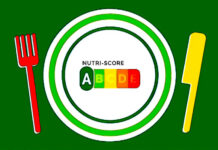Researchers at the University of Parma (Italy) have just published a scientific review (Andreani et al., 2025) which confirms the role of the Nutri-Score in improving consumers’ understanding of nutritional information. The Nutri-Score system, which uses a color-coded scale from A (healthiest) to E (least healthy), simplifies complex nutritional data, making it easier for consumers to compare products and make informed choices. (1)
The study finds that Nutri-Score outperforms other labelling systems – such as the UK’s historic traffic light labels, the invisible Italian “Nutrinform battery” Italian and also the Guideline Daily Amounts (GDA), slightly modified and renamed as Reference Intakes by Food Information Regulation (EU) 1169/11 – in terms of clarity and effectiveness. As also recognised by the OECD (2024).
1) Study design and methodology
The Italian study (Andreans et al., 2025) is a systematic review that synthesizes evidence from several studies, including randomized controlled trials (RCTs), observational studies and modeling studies. The review includes data from different populations in Europe, with a focus on adults and children from different socioeconomic backgrounds. The methodology involved:
- data collection. Analysis of peer-reviewed studies published between 2010 and 2025, focusing on the impact of Nutri-Score on consumer behavior, public health outcomes, and industry reformulation;
- participant demographics. The studies included participants from France, Belgium, Germany, Spain, and the Netherlands, with sample sizes ranging from 500 to 10.000 individuals;
- experimental design. RCTs compared Nutri-Score with other labeling systems in simulated shopping environments, while observational studies monitored real-world shopping behavior before and after the introduction of Nutri-Score;
- statistical analysis. Meta-analyses were conducted to assess the overall impact of Nutri-Score on dietary choices and health outcomes.
2) Evidence-based insights: how Nutri-Score transforms food choices and public health outcomes
The researchers organized the study findings into four main areas.
2.1) Better understanding by consumers
Nutri-Score was found to be more effective than other labeling systems in helping consumers identify healthier products:
– simplified information is particularly important for people with limited nutritional knowledge, as it reduces the cognitive effort required to interpret food labels;
– a study by Egnell et al. (2018), for example, showed that Nutri-Score improved product classification accuracy by 25%, compared to traffic light labels, which are actually more complex. (2)
2.2) Impact on purchasing behavior
The RCT studies showed that products with a favorable Nutri-Score (A or B) were 30% more likely to be chosen than those with a lower score (3). This effect was particularly pronounced among low-income populations, as highlighted by Chantal et al. (2020) (4).
2.3) Public health benefits
Modelling studies predicted that widespread adoption of the Nutri-Score could reduce the prevalence of obesity by 5% and cardiovascular diseases of 3% over a 10-year period (5).
2.4) Reformulation of the industry
Revision found that Nutri-Score incentivized food manufacturers to reformulate the products to improve their scores. For example:
– a study in France (Ducrot et al., 2021) reported a 15% reduction in sugar and salt content in reformulated products; (6)
– further confirmation was provided by a comparative analysis (Bauner et al., 2024) of the overall trends of nutritional quality in different markets. (7)
3) Discussion
The discussion highlights the strengths and limitations of Nutri-Score. While the system is lauded for its simplicity and effectiveness, some critics argue that it may oversimplify nutritional information or fail to account for certain dietary contexts (e.g., ultra-processed foods with favorable scores).
The authors respond to these concerns by citing evidence that the Nutri-Score is regularly updated, both for foods that for beverages, to improve its accuracy and relevance.
It should be added, as already clarified from the creator of the Nutri-Score, Professor Serge Hercberg, who:
– by definition, a nutritional logo provides information on the nutritional composition/quality of foods and, for scientific reasons, does not include in its calculation other health aspects of foods that are not of a nutritional nature, such as ultra-processing (related to industrial processes), the presence of additives, newly processed compounds and pesticide residues. Therefore, a nutritional logo cannot be asked to provide more information than it can provide;
– in 2021, a black border around the Nutri-Score logo was also proposed, with the wording “ultra-processed”. For the specific purpose of keeping the evaluation parameters separate, precisely because of their independence. Ultra-processed foods, while potentially harmful, can in fact present acceptable nutritional profiles. And minimally processed foods, on the contrary, can have poor nutritional properties;
– the Nutri-Score is not intended to replace nutritional recommendations, which remain the basis of nutrition education, but to complement them, to help at the time of purchase. Nutrition communication and education must mobilize all stakeholders: nutrition and public health structures, nutritionists and dieticians, health workers, teachers, field workers, etc.
4) Conclusions
In its conclusions, the Italian study confirmed that the Nutri-Score is a practical and scientifically validated tool to promote healthier food choices. Its ability to improve consumer understanding, influence purchasing behavior and guide industry reformulation makes it a valuable intervention in the fight against diet-related non-communicable diseases (NCDs). The authors call for wider adoption of the Nutri-Score in Europe and beyond, highlighting its potential to reduce health inequalities and improve public health outcomes.
Dario Dongo
Footnotes
(1) Andreani, G., Sogari, G., Wongprawmas, R., Menozzi, D., & Mora, C. (2025). Nutri-Score and Eco-Score Labeling: A Systematic Review of Their Impact on Consumer Understanding, Attitudes, and Behaviors. Food Reviews International 1-25. https://doi.org/10.1080/87559129.2025.2460052
(2) Egnell, M., et al. (2018). “Nutri-Score: A Front-of-Pack Label to Support Healthier Food Choices.” Nutrients, 10(10), 1475. DOI: 10.3390/nu10101475
(3) Julia, C., et al. (2018). “Impact of the Nutri-Score Front-of-Pack Nutrition Label on Purchasing Intentions.” PLoS ONE, 13(8), e0202095. DOI: 10.1371/journal.pone.0202095
(4) Chantal, J., et al. (2020). “Effectiveness of Nutri-Score in Guiding Low-Income Populations Toward Healthier Food Choices.” Appetite, 152, 104763. DOI: 10.1016/j.appet.2020.104763
(5) Hercberg, S., et al. (2020). “Nutri-Score and Public Health: A Review of Evidence and Policy Implications.” Public Health Nutrition, 23(5), 912-920. DOI: 10.1017/S1368980019003249
(6) Ducrot, P., et al. (2021). “Impact of Nutri-Score on Food Reformulation: Evidence from France.” European Journal of Clinical Nutrition, 75(3), 456-463. DOI: 10.1038/s41430-020-00752-9
(7) Christoph Bauner and Rajib Rahman (2024). The effect of front-of-package nutrition labeling on product composition. European Review of Agricultural Economics. Vol 00 (00), 1-24. DOI: https://doi.org/10.1093/erae/jbae004
Dario Dongo, lawyer and journalist, PhD in international food law, founder of WIISE (FARE - GIFT - Food Times) and Égalité.








